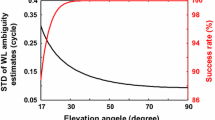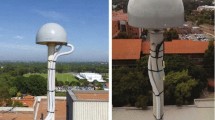Abstract
In spite of significant research in the development of efficient algorithms for three carrier ambiguity resolution, full performance potential of the additional frequency signals cannot be demonstrated effectively without actual triple frequency data. In addition, all the proposed algorithms showed their difficulties in reliable resolution of the medium-lane and narrow-lane ambiguities in different long-range scenarios. In this contribution, we will investigate the effects of various distance-dependent biases, identifying the tropospheric delay to be the key limitation for long-range three carrier ambiguity resolution. In order to achieve reliable ambiguity resolution in regional networks with the inter-station distances of hundreds of kilometers, a new geometry-free and ionosphere-free model is proposed to fix the integer ambiguities of the medium-lane or narrow-lane observables over just several minutes without distance constraint. Finally, the semi-simulation method is introduced to generate the third frequency signals from dual-frequency GPS data and experimentally demonstrate the research findings of this paper.





Similar content being viewed by others
References
Collins J (1999) Assessment and development of a tropospheric delay model for aircraft users of the global positioning system, Technical Report No. 203, University of New Brunswick, New Brunswick, Canada
Feng Y, Rizos C, Higgins M (2007) Multiple carrier ambiguity resolution and performance benefits for RTK and PPP positioning services in regional areas, In: Proceedings of ION GNSS 20th international technical meeting of the satellite division, 25–28 September 2007, Fort Worth, TX, USA, pp 668–678
Feng Y (2008) GNSS three carrier ambiguity resolution using ionosphere-reduced virtual signals. J Geodesy 82(12):847–862
Feng Y, Li B (2008) A benefit of multiple carrier GNSS signals: regional scale network-based RTK with doubled inter-station distances. J Spatial Sci 53(1):135–147
Forssell B, Martin-Neira M, Harris R (1997) Carrier phase ambiguity resolution in GNSS-2. In: Proceedings of ION GPS-97, 16–19 September 1997, Kansas City, pp 1727–1736
Hatch R, Jung J, Enge P, Pervan B (2000) Civilian GPS: the benefits if three frequencies. GPS Solut 3(4):1–9
Henkel P, Cünther C. (2007) Integrity analysis of cascaded integer resolution with decorrelation transformations. In: Proceedings of the institute of navigation, National Technical Meeting, San Diego
Ji S, Chen W, Zhao C, Ding X, Chen Y (2007) Single epoch ambiguity resolution for Galileo with the CAR and LAMBDA methods. GPS Solut 11:259–268
Leick A (2004) GPS satellite surveying, 3rd edn. Wiley, New York
Li B (2008) Generation of third code and phase signals based on dual-frequency GPS measurements. In: ION GNSS 2008, 16–19 September 2008, Savannah, GA, USA, pp 2820–2830
Richert T, EI-Sheimy N (2007) Optimal linear combinations of triple frequency carrier phase data from future global navigation systems. GPS Solut 11:11–19
Vollath U, Birnbach S, Landau H (1998) Analysis of three carrier ambiguity resolution (TCAR) technique for precise relative positioning in GNSS-2. In: Proceedings of ION GPS98, 15–18 September 1998, pp 417–426
Acknowledgments
This work is supported by Cooperative Research Centre for Spatial Information (CRC-SI) project 1.04 for regional GNSS positioning, the National Natural Science Funds of China (Grant No. 40674003; 40874016) as well as the Key Laboratory of Advanced Engineering Surveying of SBSM (Grant No. TJES0809). The authors are very grateful to the editor-in-chief Professor Alfred Leick for his constructive comments and suggestions on the manuscript.
Author information
Authors and Affiliations
Corresponding author
Rights and permissions
About this article
Cite this article
Li, B., Feng, Y. & Shen, Y. Three carrier ambiguity resolution: distance-independent performance demonstrated using semi-generated triple frequency GPS signals. GPS Solut 14, 177–184 (2010). https://doi.org/10.1007/s10291-009-0131-6
Received:
Accepted:
Published:
Issue Date:
DOI: https://doi.org/10.1007/s10291-009-0131-6




